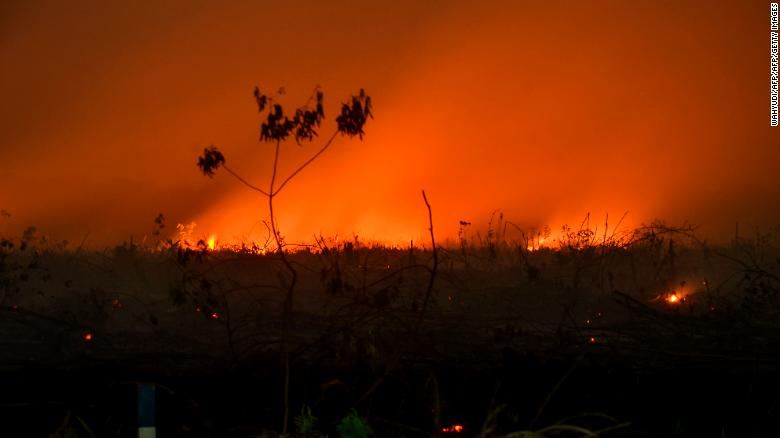Indonesia arrests around 200 as thick smog from forest fires reaches hazardous levels

The country’s National Police spokesman Dedi Prasetyo said Monday that 185 people had been arrested across six provinces hit by fires and four corporations were under investigation. He added that “99% of the forest and land fires occurred due to human factors.”Fires and ensuing smog are a persistent problem during the summer months caused by slash and burn techniques to clear the land — the same practice that led to fires in the Brazilian Amazon earlier this year.As of this year, more than 328,000 hectares (about 800,000 acres) of land have been burned, hundreds of residents evacuated, and more than 9,000 personnel have been deployed to battle the flames, according to Indonesia’s National Board for Disaster Management. The fires have impacted the lives of people across the region. Singapore and Malaysia have both choked in a dense haze all week as a result of the fires, with air quality reaching unhealthy levels.More than 600 schools have closed in Malaysia because of the air pollution, affecting hundreds of thousands of students, according to the Singapore-based Straits Times. Schools in parts of Indonesia’s smog-hit Sumatra and Borneo islands have also shut, with air quality considered “hazardous” to health in several areas. Authorities are now scrambling for a solution to the crisis. Indonesian President Joko Widodo said Tuesday that 52 planes were conducting water bombing operations against the forest fires and 5,500 additional personnel were deployed in haze-hit Riau province on Sumatra. After leading a prayer meeting in Riau province’s Pelalawan, the Indonesian leader stressed that the best way to stop the haze is “prevention before the incident” and vowed to crack down on “arsonists” behind the fires. Both Malaysia and Indonesia are inducing artificial rain through cloud seeding methods in a bid to aid relief efforts. Hazardous levels of pollutionDuring Jokowi’s visit to Pelalawan, air pollution exceeded 300 micrograms per cubic meter — levels considered hazardous on the Air Quality Index (AQI), according to the country’s Antara news agency. In nearby Jambi province, air quality had deteriorated to 407 micrograms per cubic meter, while Sampit on Borneo Island reached 427 Wednesday. A reading of 150 is considered “unhealthy,” while below 50 is “good.” AQI measures a variety of pollutants to gauge air quality, which is typically defined by the concentration of fine particulate matter, or PM2.5, per cubic meter. The microscopic particles are considered particularly harmful because they are small enough to lodge deep into the lungs and can pass into other organs or the bloodstream, thus increasing the risk of cardiovascular and respiratory diseases and cancer, according to the World Health Organization (WHO).The unusually high AQI levels in the region have been linked to smoke from the Indonesian fires, according to the Asean Specialised Meteorological Centre (ASMC). The ASMC website described “persistent hotspots with extensive moderate to dense smoke haze” in Indonesia’s Sumatra and Kalimantan regions, which have been detected for several weeks now by satellite data.Several states in Malaysia also recorded unhealthy levels of air quality in the past 24 hours, with Sri Amin in Sarawak on Borneo Island reaching a “hazardous” peak of 397. Singapore’s National Environment Agency (NEA) issued a health advisory last Tuesday, also pointing to the Indonesian fires as the cause of the pollution and warning residents to stay indoors. According to the NEA, there were 1,286 hotspots detected in Sumatra and Kalimantan on Tuesday.Deteriorating air quality is also threatening to impact the Singapore Grand Prix this weekend, a marquee annual event for the city state and a major tourist attraction. The problemFor around two decades, large paper and palm oil plantations have farmed the rich peatlands that run along the Sumatran coast of Indonesia and the island of Borneo.Every year, existing farmland is dried out and burned for the next season’s crop and to clear surrounding forests for expansion. The fires are large and hard to control. The dry, carbon dioxide-rich peatlands can burn for many weeks.At times, the AQI in Indonesia has reached as high as 1,000, with visibility falling below 100 meters (328 feet). Authorities in Indonesia have long tried to put a stop to the illegal practice, and those found guilty can be fined up to 10 billion rupiah ($700,000), while managers of firms doing the burning can face up to 10 years in jail. Despite this however, the fires have continued. Last month, Jokowi said he felt felt “embarrassed” by the fires, acknowledging the smoke’s effects on Singapore and Malaysia, according to local media Bernama.CNN’s Jessie Yeung, Michael Guy and Tom Sater contributed.







